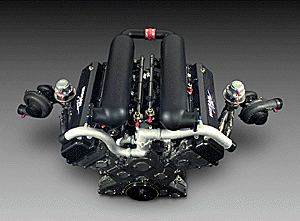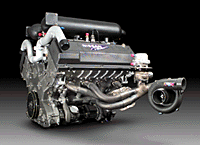| |
The Engine of R390

 The R390 GT1 is equipped with a VRH35L engine.
People who are familiar with motor racing will recognize this engine.
The engine in the R90 CP, which obtained a pole position in the
1990 Le Mans race (and unfortunately lost to the Jaguar
designed by this year's designer of the R390, Tony Southgate),
was a VRH35Z engine. After competing in the 1990 Le Mans
race, the car sporting the same engine went on to win the
Daytona 24-hour race two years later. Since 1993, when the
JSPC broke up and racing with V8 engines was cancelled, a soon
return is desired with continued development only at this
stage.
The R390 GT1 is equipped with a VRH35L engine.
People who are familiar with motor racing will recognize this engine.
The engine in the R90 CP, which obtained a pole position in the
1990 Le Mans race (and unfortunately lost to the Jaguar
designed by this year's designer of the R390, Tony Southgate),
was a VRH35Z engine. After competing in the 1990 Le Mans
race, the car sporting the same engine went on to win the
Daytona 24-hour race two years later. Since 1993, when the
JSPC broke up and racing with V8 engines was cancelled, a soon
return is desired with continued development only at this
stage.
The development of the R390 was much shorter than
commonly thought. At the shakedown test at Estoril, all of
the drivers praised the performance of the engine, saying that
it was easy to handle and possessed great power. Its
brilliant achievement of securing a pole position in the pre-
qualifying race underlines the fact that it is an advanced
engine.
When development of the R390 GT1 began last year, there
were a number of engines to choose from. The first was an in-
line 6-cylinder RB26 DETT which was used in the 1995 and 1996
Le Mans races. The second was a V8 engine more advanced than
that found in Group C cars and at the heart of future race car
engines. The third choice was a totally new type of engine.
 Because of the lack of development time, the third choice
was dropped. But the selection between the RB and V8 engines
was slow because the maximum engine output is the same as that
of engines with regulations limited by the restrictor. The V8
engine was finally chosen for the following three reasons.
Because of the lack of development time, the third choice
was dropped. But the selection between the RB and V8 engines
was slow because the maximum engine output is the same as that
of engines with regulations limited by the restrictor. The V8
engine was finally chosen for the following three reasons.
- In modern race cars which use the engine as a stress member of the chassis, a shorter, wider V8 engine would provide more efficient chassis durability.
- The shorter V8 engine reduces the Z axle rotation time and improves turn-in.
- The cylinder block of the VRH35 is aluminum as opposed to the cast steel model of the RB26 DETT. There is a 20 kg difference in weight. It is possible to use a heavier material for greater body durability.
In the redesigning of the engine, the VRH35L was based on
the VRH35Z with an emphasis on the regulation of air flow
volume from the restrictor instead of a fuel regulation, which
was important at the time the VRH35Z was in use. Design
modifications were made to the intake and exhaust system, the
major movement system, and the cooling system, all involved
with increasing the combustion efficiency and combustion
pressure.
In a 24-hour endurance race, reliability and durability
are as important as, or even more important than, output
characteristics. A computer-controlled engine testing device
(as seen on a TV commercial) that simulates the conditions at
the Sarthe Circuit completed a 30-hour continuous test while
improvements in the endurance reliability of the actual car
will continue until the start of the race.
|

 ISSUED :1997.5.28
ISSUED :1997.5.28
 ISSUED :1997.5.28
ISSUED :1997.5.28